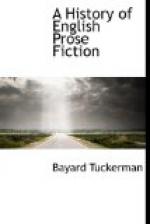There is probably no writer with whose works his life and personality are more intimately connected. It is impossible to consider the one separate from the other. Defoe began to write novels as a tradesman, as a literary hack, and as a reformer. Being dependent on his pen for his bread, he wrote what was likely to bring in the most immediate return. He calculated exactly the value and quality of his wares. He gave to his fictions the same moral object which inspired his own life. His novels followed naturally on his other labors, and partook of their character. It was his custom, on the death of any celebrated person, to write his life immediately, and to send it to the world while public interest was still fresh. But being often unable to obtain complete or authentic information concerning the subject of his biography, he supplemented facts and rumors by plausible inventions. Fiction entered into his biographies, just as biography afterward entered into his novels. But in writing the lives of real individuals Defoe recognized the necessity of impressing his reader with a sense of the truth and exactitude of the narrative. This effect he attained by the use of a literary faculty which he possessed in a degree unequalled by any other writer—that of circumstantial invention. By the multiplication of small, unimportant details, each one of which is carefully dwelt upon, and by the insertion of uninteresting personal incidents and moral reflections, seeming true from their very dulness, he gave to his work a remarkable verisimilitude. He did not even issue the book under his own name, but invented an authorship which would attract attention and credibility. Thus the “History of Charles XII” was announced on the title-page as “written by a Scot’s gentleman in the Swedish service”; and the “Life of Count Patkul” was “written by a Lutheran minister who assisted him in his last home, and faithfully translated out of a High Dutch manuscript."[156] The same characteristics appear in all Defoe’s works. He invents freely, giving the most elaborate details to support his assertions, and attains to an extraordinary degree the art of “lying like truth.” In the “Journal of the Plague Year,” Defoe assumed with his accustomed ease and skill the character of a plain, blunt London shopkeeper. He described with such apparent accuracy the observations of a man who had lived in the scene of that terrible calamity, giving curious incidents, anecdotes, statistics, after so methodical a manner, that it was long before any doubts were cast on the authenticity of the journal. It was a work of imagination, but so matter-of-fact, that it is difficult to believe the author had any imagination, and that he had not actually witnessed every occurrence he so calmly related. It is the same with the “Memoirs of a Cavalier.” The civil wars are described by a young officer who took part in them, who gives a detailed account of his own opinions, his wardrobe, his horse, his lodgings. Lord Chatham quoted these memoirs as the true account of an eye-witness. From writing the life of a well known individual, Defoe had advanced to writing the life of a fictitious person placed amidst historical scenes. His next step was to write the life of a fictitious person amidst fictitious scenes.[157]




